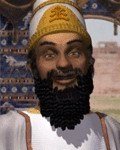The Sumerians |
|||||||||||||||||||||||
| Profile | |||||||||||||||||||||||
|
|||||||||||||||||||||||
|
Sumerian Cities
Great Leaders Military Leaders:
Scientific Leaders:
|
Background Sumeria’s first and greatest accomplishment was the extent to which its people controlled their environment. They drained swamps, dug canals, and generally bent the Euphrates region to their needs. They plowed the land for the first time in history, and took advantage of the rich, fertile Mesopotamia soil. However, the area was low on other resources, so the Sumerian city-states were forced to import goods (particularly metals). Thus they had to create a barter system of trade, as well as riverboats to more easily traverse the rivers that flanked their home. The invention of the plow led in turn to the invention of the wheel, which permitted animals to pull carts as well as plow fields, and also to the creation of better pottery (with potters’ wheels). Since specialists were now able to create goods, and not every man had to farm, full-time priests could administer community affairs as well as the temples in each city. To support them, in turn, people had time to devise picture signs and other very early alphabets, and being a full-time scribe became a viable profession. The literature of Sumeria followed thereafter, culminating in the Epic of Gilgamesh, a lengthy poem dedicated to the mythic god-king whose real and legendary exploits blend together. A companion of Gilgamesh, Enkidu, fought by Gilgamesh’s side in many battles, and for him the Enkidu Warriors are named: fierce fighters who sought to defend Sumerian lands from the other civilizations being born nearby. The literature of the Sumerians was not limited to stories, though. In fact, one fact of modern life is still as Sumeria designed it. The Sumerian priesthood developed an early mathematics for commercial and religious purposes, and their number system was based around the number 60. Thus time itself is divided into units of 60 seconds in a minute, 60 minutes in an hour, and so forth. The 24-hour day also originates with Sumerian calendars, as does the 360-degree circle. So the fingerprints of the world’s most ancient civilization are still visible today. Sumeria’s end came gradually, as barbarians saw what they had achieved and strove to emulate it. About 1,500 years after the first Sumerian cities took form, Amorite nomads settled near Ur in a place called Babylon. The resulting civilization grew into a mighty kingdom in its own right, and when Elamite invaders (from modern-day Iran) sacked Ur, Babylon (which then still styled itself Akkad) saw its opportunity to eclipse its sire. They went in, dispersed the Elamites, and rebuilt Ur in their own image. Sumerian culture and language persisted, but slowly assimilated into the new dominant empire. Sumeria disappeared completely as an autonomous culture by 1900 BC. In Civilization III: Conquests, the Sumerians are considered to be a scientific and agricultural civilization. They start the game with Bronze Working and Pottery and build Enkidu Warriors instead of Warriors. They also cannot build Spearmen. Unique Unit: Enkidu Warrior The Enkidu Warrior is named for Enkidu, a near-savage man created by the Sumerian god Anu to accompany and aid Gilgamesh on his quest for immortality. Enkidu was a fierce warrior and prophet, and the Sumerian armies strove to emulate his ferocity in battle and his iron loyalty to the King. The Sumerian Enkidu Warrior is a very tough early defensive unit.
|
||||||||||||||||||||||

 The Sumerians were, by historical consensus, the first human civilization. Originally from Asia Minor, they settled between the Tigris and Euphrates (in modern-day Iraq) and began to farm and create simple goods. They relied on a sort of theocratic city-state government, where each Sumerian city worshipped a separate god and had a separate governor, although all paid tribute to a single King in the capital, Ur.
The Sumerians were, by historical consensus, the first human civilization. Originally from Asia Minor, they settled between the Tigris and Euphrates (in modern-day Iraq) and began to farm and create simple goods. They relied on a sort of theocratic city-state government, where each Sumerian city worshipped a separate god and had a separate governor, although all paid tribute to a single King in the capital, Ur. 